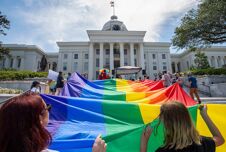The most popular symbol of the LGBTQ community, the rainbow flag, represents a diverse range of sexualities. But did you know that there is a specific flag for men who love men?
Learn more about the MLM flag and what its colors symbolize, as well as some of the other symbols that have represented MLM pride over the years.
Related: Florida high school student waving Pride flag comes out at graduation to defy Don’t Say Gay law
What Does MLM Mean?
MLM is an acronym that stands for “men loving men”. The term describes anyone who identifies as a man and is attracted to men. It is inclusive of (but not limited to) men who identify as gay, bisexual, pansexual, gender non-conforming, and transgender.
Never Miss a Beat
Subscribe to our newsletter to stay ahead of the latest LGBTQ+ political news and insights.

What Does The MLM Pride Flag Look Like?
Many people assume that the rainbow pride flag (also known as the gay flag) and the MLM flag are one and the same. But while the rainbow pride flag represents the entire LGBTQ community, there is a relatively new flag that was made specifically to represent men who love men.
This flag was created as a counterpart to the lesbian pride flag and is designed to mirror it. It consists of seven stripes, with each color representing some of the traits and experiences that MLMs value.
MLM Flag Meaning And Colors
These are the meanings behind each color on the MLM pride flag:
- Green: Represents community. Community is the driving force behind the LGBTQ movement. As a marginalized group, MLMs need a strong sense of community to draw strength and wisdom from and take refuge in.
- Teal: Represents healing. Gay, bisexual, pansexual, and transgender men have and continue to face discrimination, violence, rejection, and stigmatization for living their truth, and thus have a deep need for people and safe spaces where they can heal.
- Light green: Represents joy. Joy has the power to heal, bring people together, and inspire hope.
- White: Represents trans men, nonbinary people who connect with masculinity, and gender non-conformity.
- Light blue: Represents love – romantic love, love among friends, and the love fostered by the community.
- Purple: Represents the courage of all the activists and advocates who have fought for equality and the courage it takes to live authentically.
- Dark purple: Represents diversity and inclusivity.

Gay Pride Flags & Symbols Through The Years
Before the seven-color flag, MLMs have used a variety of symbols to represent their community, including:
The Rainbow Pride Flag
The pride flag we all know and love today was designed by Gilbert Baker, an artist and drag queen, in 1978. The catalyst for the flag’s creation was the late San Francisco city Supervisor Harvey Milk, who urged Baker to create a symbol of pride for the LGBTQ community.
Baker wanted a symbol that wasn’t associated with the dark history of violence and persecution against LGBTQ people, drawing inspiration from the use of the American flag to represent pride and community. Baker’s original rainbow flag consists of eight colors, each with its own meaning:
- Hot pink: Sex
- Red: Life
- Orange: Healing
- Yellow: Sunlight
- Green: Nature
- Turquoise: Magic and art
- Indigo: Harmony
- Violet: Spirit
After several years, the pink and indigo stripes were removed and turquoise was replaced with blue. Over time, Baker’s flag has been updated and adapted to better represent the diversity of the LGBTQ community. The most recent redesign – one that is being propped up to replace the original flag – is the Progress Pride flag.
Designed by non-binary artist Daniel Qasar as a response to the rise in police brutality in America, the Progress Pride flag includes five angled stripes on the left forming a triangle, with the first three bearing the colors of the trans flag, and the last two brown and black stripes representing people of color.
View this post on Instagram
The Inverted Pink Triangle
One of the oldest symbols representing the LGBTQ community, the pink triangle has its roots in Nazi Germany. During WWII, gay people were placed in concentration camps alongside Jews, Roma, communists, and common criminals. To differentiate prisoners and allow a social hierarchy to form within the prison, each group was designated a specific color and symbol.
After WWII, pioneers of the gay liberation movement used the pink triangle as an identifier. It served as a way to reclaim the symbol from its dark past and a nod to the history of persecution that LGBTQ people have faced.
View this post on Instagram
The Green Carnation
The green carnation is a lesser-known symbol that was popular in the late 1880s. Playwright and gay icon Oscar Wilde first wore the green carnation in 1892, displaying the flower on his lapel and instructing a small group of his friends to do the same on the opening night of his comedy Lady Windermere’s Fan. After that night, MLMs would wear carnations on their lapel as a subtle hint to others that they were interested in men.
Recently, trans actor Elliot Page donned an oversized Balenciaga suit with a single green rose pinned to the lapel to the 2021 Met Gala, igniting debates online on whether the choice was an obvious nod to Wilde.
View this post on Instagram
Final Thoughts
The recent addition of the MLM flag is a testament to the LGBTQ community’s rich history of adopting and creating symbols to represent their pride. We’re bound to see this flag evolve and change over the years, just as the community does, and we’re excited to see what the future holds.
Related: Marjorie Taylor Greene slammed for asking what Nazis think of a fake Pride flag














